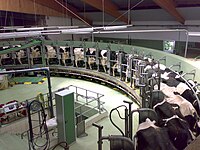
Photo from wikipedia
Several studies have investigated which management practices have the greatest effect on udder health, but little information is available on how broadly the recommended milking practices are adopted across Canada.… Click to show full abstract
Several studies have investigated which management practices have the greatest effect on udder health, but little information is available on how broadly the recommended milking practices are adopted across Canada. The National Dairy Study 2015 was designed to gather dairy cattle health and management data on dairy farms across Canada. The objectives of the present study were to describe the current proportions of adoption of milking practices on Canadian dairy farms, and identify factors associated with their use on farms. A bilingual questionnaire measuring use of various practices, including an udder health-specific section, was developed and sent to all Canadian dairy farms. The questions in the udder health section of the questionnaire were adapted from a bilingual questionnaire previously validated and containing questions regarding general milking hygiene and routine, and on-farm mastitis management. Chi-squared tests were used to investigate simple associations between adoption of practices and various explanatory variables including region, milking system, herd size, and bulk tank somatic cell count. In total, 1,373 dairy producers completed the survey. The regional distribution of the participants was representative of the Canadian dairy farm population, and milk quality was, on average, similar to nonparticipants. Overall, Canadian dairy producers followed the recommendations for milking procedures, but some were more extensively used than others. Fore-stripping, cleaning teats, wiping teats dry, using single-cow towels, and use of postmilking teat disinfectant were widely adopted. Use of gloves and glove hygiene, use of a premilking teat disinfectant, and use of automatic takeoffs were not as extensively implemented. Adoption percentages for several practices, including use of gloves, use of a premilking teat disinfectant, teat drying methods, and use of automatic takeoffs were significantly associated with milking system, herd size, and region. It would be helpful to explore the reasons why producers choose to adopt or ignore recommended milking practices as most are easy to include in the routine and are fairly inexpensive.
Journal Title: Journal of dairy science
Year Published: 2017
Link to full text (if available)
Share on Social Media: Sign Up to like & get
recommendations!